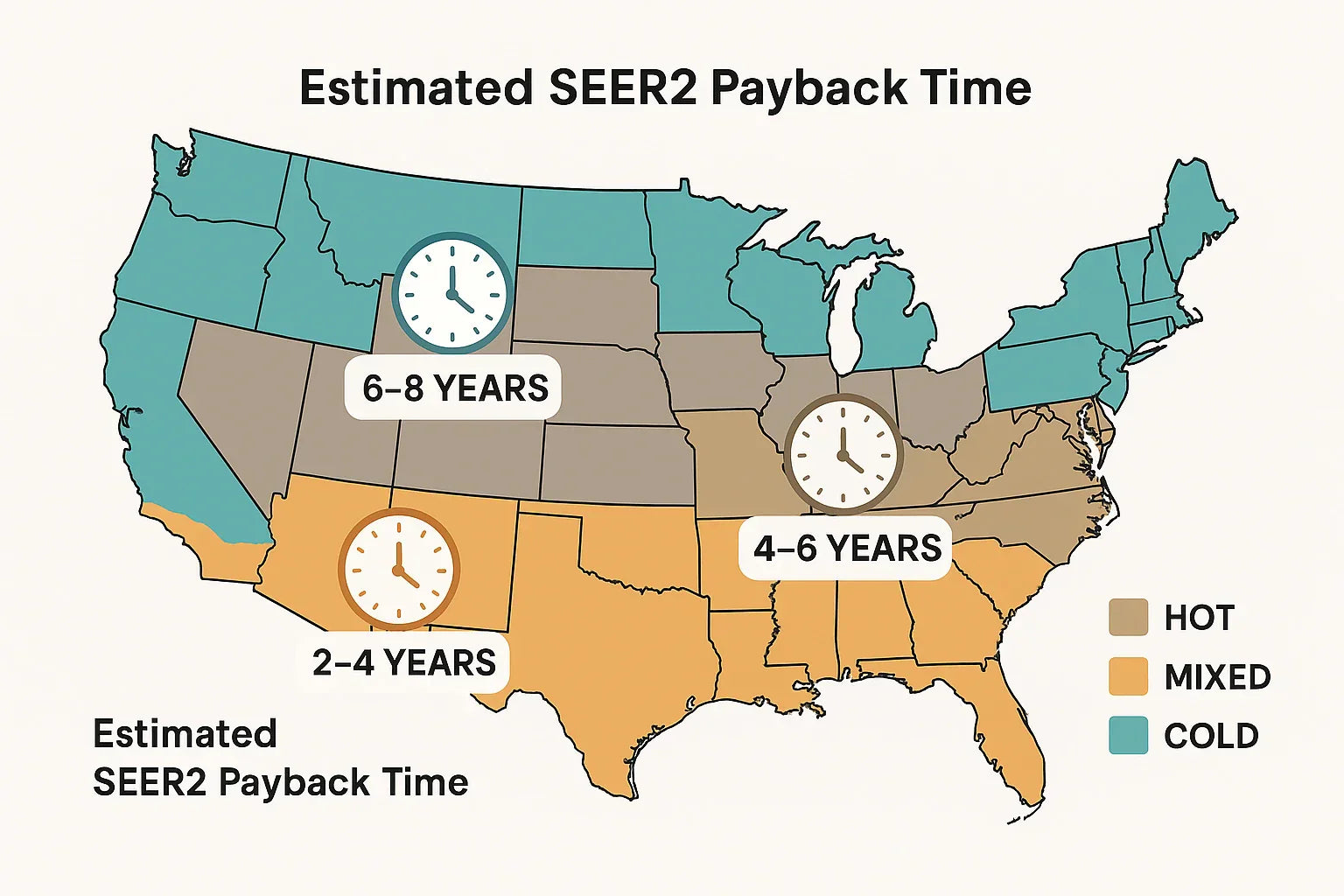When it comes to upgrading your HVAC system, efficiency ratings like SEER2 are just one part of the story. The other? Your climate zone.
A higher SEER2 rating means better energy efficiency — but how quickly that investment pays off depends heavily on where you live and how often you use your air conditioner.
If you live in Phoenix, a high-SEER2 system could pay for itself in just a few years. But in Seattle? You might be waiting a decade or more.
📘 Want the full scoop on SEER2? Start here:
👉 What is SEER2 and Why It Matters
Understanding SEER2 and Seasonal Usage
SEER2 stands for Seasonal Energy Efficiency Ratio 2, and it measures cooling output over an entire season, divided by the electricity used. But “seasonal” is the keyword here — your cooling season length varies by region.
-
Hot, humid climates = Longer AC runtime = More potential savings
-
Mild climates = Limited cooling use = Slower return on efficiency upgrades
That’s why SEER2 is best understood in context with your home’s location, usage patterns, and local energy rates.
📘 DOE – Guide to Home Heating & Cooling
Hot and Humid Regions: Where SEER2 Shines
If you live in the Southeast, South Central, or Southwest U.S., your cooling season can last 6–9 months out of the year. That’s a lot of runtime — and a major opportunity to save.
Key Cities:
Miami, Houston, Atlanta, Phoenix, Las Vegas
SEER2 Impact:
-
A 17 SEER2 system can save hundreds of dollars per year in energy bills compared to a 14.3 SEER2 baseline
-
Shorter payback periods: as little as 4–6 years depending on usage and utility rates
-
Utility rebates and tax incentives often apply in these regions
📘 Energy Star – Climate Zone Map & Recommendations
Mild or Mixed Climates: Look Closely at the Math
In places like the Pacific Northwest, Bay Area, or upper Midwest, summer is short and relatively mild. Your system may only run for a few weeks — or not at all during cool summers.
Key Cities:
Seattle, San Francisco, Minneapolis, Detroit
SEER2 Impact:
-
Fewer annual cooling hours = smaller energy savings
-
Upgrading from 14.3 to 17 SEER2 may take 10+ years to pay off
-
Lower utility rates and moderate temperatures reduce the value of high-SEER2 equipment
Bottom Line:
You may still want a premium system for comfort or noise reduction, but pure ROI will be slower.
📘 ACEEE – SEER2 Savings by Region
Cold Regions: Consider Heat Pumps with High HSPF2
In colder climates, air conditioners may not run at all — but heat pumps can deliver both heating and cooling. That’s where SEER2 and HSPF2 (heating efficiency) ratings need to be considered together.
Key Cities:
Boston, Chicago, Denver, Buffalo
SEER2 Impact:
-
Standalone SEER2 upgrades may offer limited summer value
-
Consider cold climate heat pumps rated highly in both SEER2 and HSPF2
-
Look for dual-fuel options if backup heating is needed in sub-zero temps
📘 NEEP – Paving the Path to Deeper Heat Pump Adoption
Example: SEER2 Payback in Two Cities
Let’s compare real-world numbers using a 2,000 sq ft home upgrading from a 12 SEER system:
| Region | Upgrade To | Cooling Days/Year | Estimated Savings/Year | Estimated Payback |
|---|---|---|---|---|
| Phoenix, AZ | 17 SEER2 | 220+ | $350–$500 | 5–7 years |
| Portland, OR | 17 SEER2 | ~30 | $40–$60 | 15+ years |
The math is clear: warmer = faster ROI.
📘 Trane – HVAC Payback Analysis
Other Factors That Influence Payback
-
Electricity Rates – States with higher utility costs see faster ROI on efficient systems
-
Rebates and Credits – Local incentives can cut years off your payback period
-
Ductwork and Installation Quality – A high-SEER2 unit installed poorly won’t perform
-
System Size – An oversized or undersized unit will struggle to hit its rated SEER2 efficiency
Final Thoughts from Alex Lane
A SEER2 upgrade isn’t just about the sticker on the unit — it’s about how your home and climate interact with that system day after day.
If you live in a region where AC use is consistent and electricity is expensive? A 17 SEER2 unit is a smart long-term investment.
If you only cool a few weeks a year? Stick with 14.3 SEER2 and focus on better insulation or zoning instead.
Always ask yourself:
-
How many days a year do I run the AC?
-
What’s my local cost per kWh?
-
Am I eligible for tax credits or rebates?
That’s the real equation behind efficiency payback — and it’s one worth solving.
👉 Curious how SEER2 affects resale and home buying decisions?
Buying a Home? What a SEER2 Rating Tells You About HVAC Efficiency
Alex Lane
Your Home Comfort Advocate







